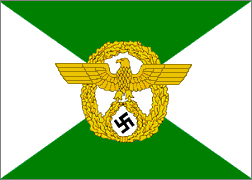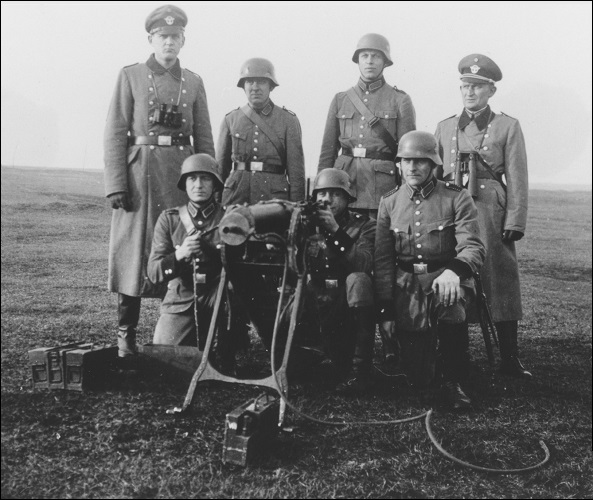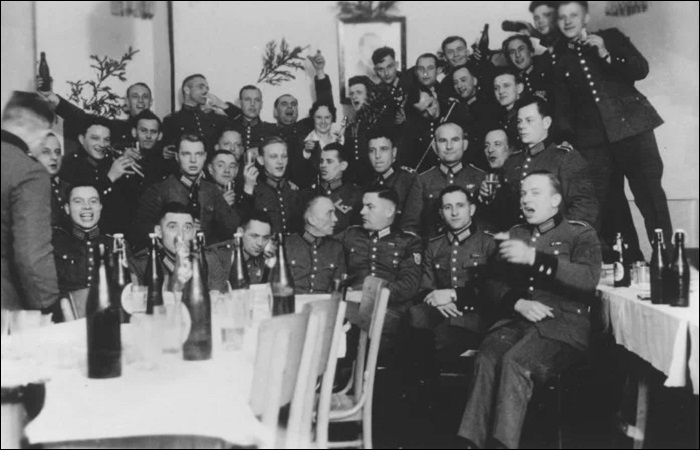One of the newly installed Nazi regime’s key objectives
was to gain control of Germany’s police forces. They were
under the control of the federal states (Lander), and
between 1933 and 1936 the ground was laid for a transfer of
police power to the central government. Herman Göring’s
appointment as Prussian Minister of the Interior was the
first step down that road. Prussia was much the biggest of
the federal states, its police force was correspondingly
large, and through Göring the Nazis gained control of it.
But as things turned out the final nationalization of the
police forces brought them under control of Heinrich Himmler,
the Reichführer-SS (SS National Leader). He was named
Chief of German Police in 1936, effectively subordinating
the regular police to the SS.
The
nationalized force had two major components:
The
Security Police (Sicherheitspolizei
or Sipo)
embodied the regular
criminal police and the secret police—the notorious
Geheime Staatspolize
(Secret State Police or Gestapo)
The
Order Police (Ordnungspolizei
or Orpo), the
regular uniformed police organization, informally known
as the Green Police from the color of its uniform
The Orpo was divided into
numerous branches: traffic police, waterways police, postal
protection police, the fire service, etc. The largest
branches were the State Protection Police (Schutzpolizei
des Reiches) for major
cities and some large towns; the Municipal Protection Police
(Schutzpolizei der Gemeinden) for most large towns and all smaller towns); and the
Gendarmerie for
rural areas. Mostly they operated out of police stations
and posts, but the State Protection Police included
so-called barracks police (Kasernierte Polizei):
paramilitary formations, quartered in barracks, for the
suppression of riots and major threats to public safety.
Such units existed in all major population centers.
Though the Orpo was
supervised by the SS, formally it remained a separate
organization and there was no requirement for policemen to
be SS members. SS membership was encouraged, however, and
policemen who held SS rank were authorized to wear the SS
runes under the left pocket of their uniform tunic. The basic
insignia of the Orpo was a wreathed National Eagle (Reichsalder),
worn as a cap and arm badge. The Orpo uniform was similar to
that of the Army, albeit in a shade of green lighter than
the latter’s Feldgrau
(field gray). Rank titles and insignia were similar to those
of the Army, though in 1942 when SS membership became mandatory
for all general officers of the ORPO, their collar
insignia was changed to SS style in green and gold
colors. Branch colors were green and brown for the
Schutzpolizei des Reiches,
dark red for the Schutzpolizei der Gemeinden
and orange for the Gendarmerie.
These branch colors were displayed on the cuffs, collar
patches and shoulder straps of the uniform tunic, and as
piping on uniform caps.

Command flag of an Order Police general,
displaying the distinctive Orpo badge
When war
came in 1939 the Orpo raised an initial seventeen police
battalions. Those intended for service in the eastern
occupied territories had a headquarters section and three
companies, each with about 150 officers and men armed with
pistols, rifles, submachine guns and light machine guns,
plus a heavy machine gun detachment. In general the police
battalions received older weapons, such as the MP 28
submachine gun, the MG 08/15 light machine gun and the MG 08
heavy machine gun. Some battalions were fully motorized but
most had only a few motor vehicles, relying largely on
bicycles. These Order Police battalions are not to be
confused with the Army's military police corps, the
Feldgendarmerie,
which was a
separate organization with different duties.
The
personnel of the first few battalions to be raised consisted
of regular policemen, but conscripts were used to form the
reserve police battalions raised in 1940-42. Only the
officers and senior NCOs of the reserve battalions were
professional policemen; the men came from the older age
groups—mid-thirties to early forties—that were considered
unfit for service with the armed forces. Relatively few were
members of the Nazi Party and even fewer held rank in the
SS. With the passage of time, however, the Orpo fell
increasingly under the sway of the SS, and in 1942-43 its
battalions were absorbed into the new SS and Police
Regiments. Though they maintained a police identity, the
battalions were from then on considered to be part of the
SS.
Initially
the police battalions were employed on security duties in
the Army rear areas: guarding prisoners of war, key
installations, road and rail communications, etc. After the
conclusion of the Polish campaign they passed under the
command of the SS and Police Leaders in the newly occupied
territories. Though their stated basic mission was the
enforcement of law and order, the police battalions were
also used to implement Nazi racial policies. In the spring
and summer of 1940 the Orpo participated in a mass expulsion
of the Polish population from the so-called Warthgau, an
area annexed by Germany that was to be seeded with German
colonists. In one action, Police Battalion 101 “evacuated”
nearly 60,000 Poles. Those found to be old or ill were often
shot on the spot. These were the first of many atrocities
that the police battalions were to commit in Poland, the
USSR and the Balkans.

Men of a police battalion manning an MG 08
heavy machine gun of World War I vintage (Bundesarchiv)
For the invasion of the
USSR (22 June 1941), twenty-three police battalions were
provided. Nine were attached to the
security divisions of the
Army for duties in the immediate rear areas of the army
groups. Twelve were used to form three Police Regiments
(North, Center, South), one for each Higher SS and Police
Leader (Höherer SS- und Polizeiführer)
attached to the army groups, plus a Special Purpose Police
Regiment (Polizei-Regiment zur besonderen
Verwendung). Of the remaining two, one was detailed to
support Organization Todt construction units and one to
support the SS Special Action Groups (SS-Einsatzgruppen)—the
extermination squads charged with the elimination of Jews
and other “harmful elements” in the newly occupied
territories.
All of
the police battalions in the USSR complied a frightful
record of atrocities, usually in conjunction with SS and
Army units. Their operations reflected official German
policy: ruthless exploitation of the resources of the
occupied territories without regard for its effect on the
population. Officials of the Communist Party who fell into
German hands were shot as a matter of course, while
“anti-partisan operations” often served as the pretext for
indiscriminate massacres of unarmed civilians. The police
battalions in the USSR and occupied Poland also played a key
role in the Final Solution—the extermination of the Jews.
In his
book, Ordinary Men: Reserve Police Battalion 101 and the
Final Solution in Poland (1992), the historian
Christopher Browning put the activities of one police
battalion under the microscope. In 1940-41 Police Battalion
101 returned from Poland to Germany, to be reorganized with
conscripted men. It was thereupon redesignated as Reserve
Police Battalion 101 and assigned to the Higher SS and
Police Leader in the so-called General Government, that part
of Poland not directly annexed by Germany. There, between
June 1942 and November 1943, it was a front-line unit of the
Holocaust, with direct responsibility for the murder of over
80,000 Jews. Reserve Police Battalion 101’s crimes against
humanity were of two categories: the roundup and mass
shooting of Jews, and the clearance of Jewish ghettos in the
General Government—meaning in practice the deportation of
their populations to the death camps farther east.

The men of Reserve Police Battalion 101
celebrate Christmas 1940 during the battalion's first tour
of duty in Poland (Bundesarchiv)
The men of Reserve Police Battalion
101 were not fanatical Nazis. Most were natives of Hamburg, a city never known
as a National Socialist stronghold. They were older men who
had come to maturity before the advent of the Third Reich,
and few were members of the Nazi Party. Nor after being
drafted into the Orpo had they been subjected to intense
ideological indoctrination. Mostly they belonged to the
lower middle class: small business owners, artisans, skilled
workers. Many were married with children. They were, as
Browning put it, ordinary men. Yet by and large they carried
out their genocidal orders without protest. A few, it is
true, balked when ordered to shoot women and children, or
begged off after participating in their first “action.”
Remarkably, such men were not punished. Rather, they were
given other duties: guarding the trucks, for instance, while
the Jews were marched into the forest to be executed.
Browning’s conclusion was that a perverted form of esprit
d’corps—each man’s fear of letting down his comrades by
refusing to join them in the dirty work—was Reserve Police
Battalion 101’s primary motivating force. And no doubt, a
decade of virulent anti-Semitic propaganda helped to
reconcile these ordinary men to their distasteful duty.
The
small number of police battalions serving in the western
occupied areas were less implicated in such atrocities. In
France, Belgium, the Netherlands, etc. the local police
remained in existence and cooperated with the German
occupation authorities. Such security duties as needed to be
carried out by German units were mostly entrusted to the
Landesschützen, the
second-line militia of the German Army. Police battalions
serving in the Balkans, however, were implicated in numerous
war crimes.
As
mentioned above, the police battalions of the Orpo were not
intended to serve as front-line combat units. But in an
emergency they could be so employed, as was the case with
the half-dozen attached to Army Group North during the
1941-42 Soviet winter counteroffensive. Such emergency
attachments happened more and more frequently as Germany’s
military situation deteriorated. However, the sole Orpo
combat unit intended as such was the Polizei-Division,
raised in 1939. The men of its three infantry regiments were
policemen, while the artillery, anti-tank, engineer and
other support units were provided by the Army. Himmler’s
intention in this was to circumvent the restrictions on the
size of the
SS-VT
(as the armed SS was known at the time) and to give Orpo
members a way of fulfilling their military service
obligation without being drafted into the
Wehrmacht. When raised,
the Polizei-Division
was not part of the SS, but later it was merged into the
Waffen-SS as
the 4. SS-Polizei-Panzergrenadier-Division.
Unlike the SS, the Order Police was not designated as a
criminal organization and most of its veterans went on to
lead normal lives in the postwar era. Some were able to
resume their police careers in both West and East Germany.
Only a few were arrested, prosecuted and
convicted of war crimes, the former commander of Reserve
Police Battalion 101 prominent among them.
Major Wilhelm Trapp was arrested by
the British Army after the German surrender and was later
and extradited to Poland, where In 1948 he
was convicted of war crimes, sentenced to death, and hanged.